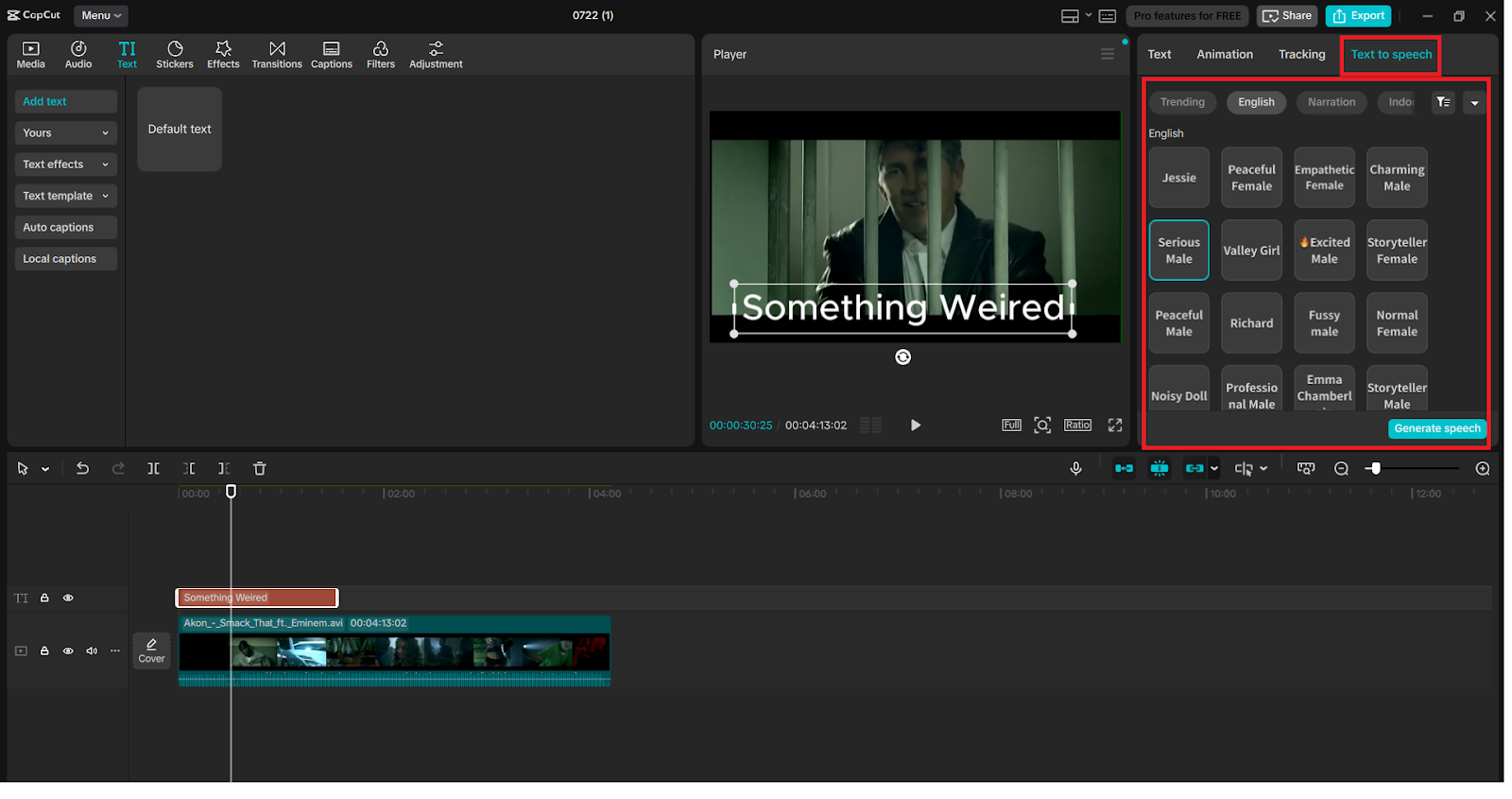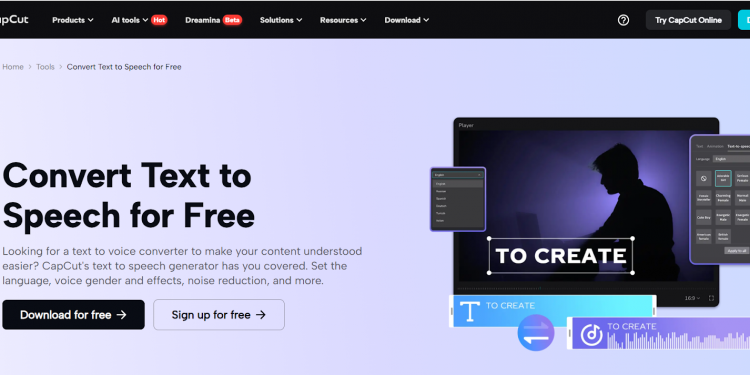Nowadays, the world of content creation is a fast-paced industry where it may be difficult to distinguish between AI-voices and the voices of real human beings. There are pros of both, as well as a potent middle ground: AI-generated but natural-sounding voices of the CapCut Text to Speech tool that enables more than just prerecorded voices to appear: they could sound as natural as they are digital. Whether you are creating YouTube videos, social media advertisements, or e-learning materials, it helps to know when using AI or real voiceovers is appropriate, in an attempt to conserve time and make the materials entertaining.
For creators looking to enhance both audio and visual quality, pairing CapCut’s AI voice generator with its powerful AI video upscaler can elevate your content to professional standards effortlessly.
The AI voice generator feature of CapCut offers professional narrations in various voices and languages that are of studio quality and are perfect for those creators who require professional voiceovers in a short time. Still, there is no substitute for sentiment and reality with human recordings. Almost every job is the same way: so how do you make up your mind?
Understanding AI Voice Technology
The text to speech AI of CapCut is one of the highest levels of technology today. The vocalisations are produced by these systems using deep learning algorithms taught using thousands of hours of human speech, resulting in voices that are becoming very difficult to differentiate from genuine recordings. The newer ones are capable of recording nuances of spoken words such as emotional inflexion, appropriate timing, and in some scenarios, even breathing patterns.
When AI Voiceovers Shine
AI voices are transforming the content production in a few important situations:
Fast Content Delivery
AI software like the voice generator is utilised when creating polished voiceovers and saving time, as when creating high-quality voiceovers under strict deadlines or at scale; CapCut can generate voiceovers in minutes instead of hours. This becomes especially useful when it comes to news channels, daily content providers, or even companies that require creating regular updates daily.
Multilingual Projects
Production of content with a worldwide audience was normally done by recruiting several voice artists. Today, text-to-speech in CapCut can work on dozens of languages and create narrations of high quality with equal precision in a matter of seconds, just the right choice when you are marketing your product in another country, or need to provide educational content in such a country or a language.
Support of Series Consistency
In the case of content series or brand messaging that warrant tone consistency on the part of the speaker, regardless of the number of episodes or instalments, AI voices make for perfect tonal consistency that may be difficult even for the best professional voice artists to keep up over the long term.
The Case for Human Voice-Over
However, human recordings can still be better in several areas despite the AI’s progress:
Emotional Storytelling
When your content really needs a true emotional human connection, such as personal vlogs, narrative podcasts, or branded storytelling, there is nothing as realistic or cozy as a human voice with its imperfect moments.
Distinctive Brand Name
Human voice can become a trademark of your brand (Morgan Freeman talking about Visa or James Earl Jones talking about CNN). To realise this kind of brand recognition using AI voices is very difficult.
Complex Pronunciation
Although the AI voices bloom and work in the case of using typical languages, they can lack competency when it comes to industry terms, unusual names, or accents that need human taste and interpretation.
Live Interaction
Human voices are also needed when the content requires the involvement of the audience, such as Q&A sessions or live reads, as these need a certain spontaneity and such ability to make changes in a moment.
CapCut’s Text to Speech: Best of Both Worlds
The AI voice generator of CapCut provides its creators with impressive middle ground and various remarkable features:
Quality Of Natural Voice
Highly developed neural networks make the speech sound natural, in terms of inflection and rhythm, and less robotic, as was the case with early text-to-speech synthesisers.
Customizable Delivery
Adapt speed, pitch, and stress as perfectly as possible to the mood and pacing needs of your content.
Various Voice Library
Select professional voices, conversational tones, or even character voices when you want to be inventive.
Seamless Integration
The AI voices fit perfectly into CapCut editing options, and they can be synced with ease with visuals, music, and sounds.
Step-by-Step: Using CapCut’s AI Voice Generator
Step 1: Import Your Project Assets
Open the CapCut and begin a “New Project”. You can import your video clips, your images, and all other media components just by clicking the “Import” button, or simply drag files into the media library. You can also edit by dragging and dropping the assets of the project into the bin and then dragging them to the timeline.
Step 2: Add Your Narration Text
Open the editing toolbar and click on the tool called “Text”. To make a new text layer, click in the preview window or on the timeline. Insert your entire script and, with the help of the text formatting features, modify the typeface, font size, as well as positioning.
Step 3: Convert Text to AI Voice
Also, having your text layer selected, find and click the “Text to speech” option in the panel of your properties. Find the list of the existing voice options, which are often divided by gender, age, and style ( e.g., Professional Male, Youthful Female, Animated Character). Audition various voices to have the right choice of voice that suits your content.

Step 4: Fine-Tune Voice Parameters
Then, once you have created the AI voiceover, select your audio track in your timeline. Click on the speed slider to change the rate of playback without changing pitch. Adjust the pitch and tone groups to make the desired voice effect you require. To edit effectively, make use of the audio waveform display to make proper cuts or edits.
Step 5: Finalise and Export
When you like the sound of your AI voiceovers, just make some last changes in terms of audio mix, with your voiceover just fitting the background music and sound effects. Press “Export” and select the best settings on the target platform (it is preferable in 1080p or 4K resolution in 60 fps on most contemporary platforms). CapCut will put your project in premium quality AI voice integration.
Final Thoughts
With an ever-improving AI voice generation, we are getting thrilling moments of emotional range and expressiveness. The text-to-speech technology developed by CapCut is one of the leaders of these innovations, and AI voices can be used in an ever-growing number of applications. Nevertheless, human voices may probably never disappear from the content that requires a real connection with emotions.






































